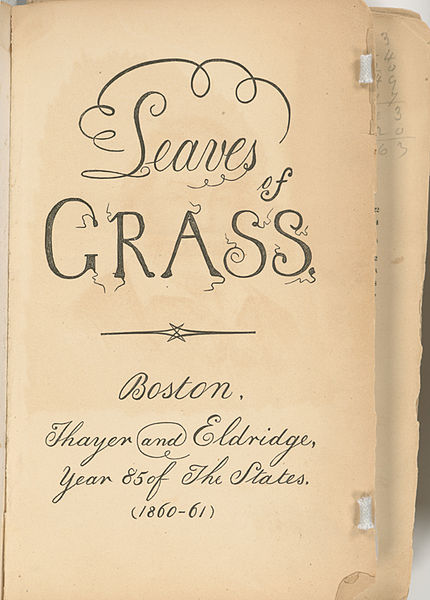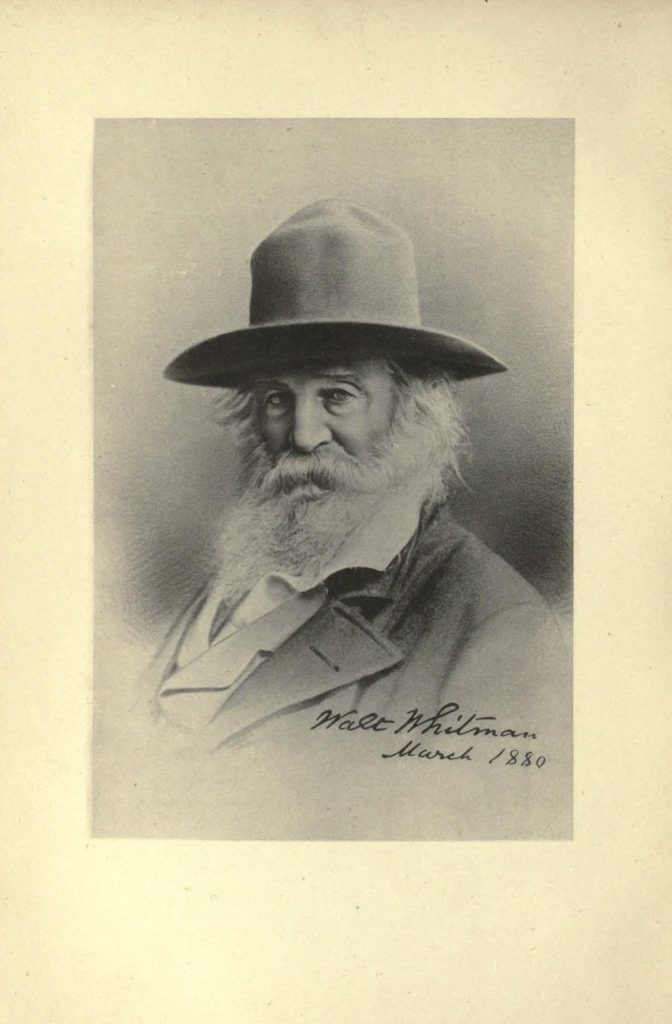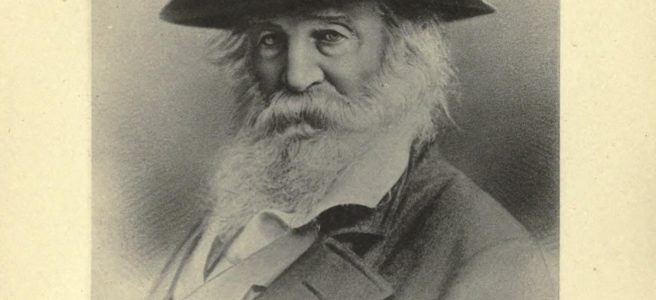Published in 1893, Walt Whitman: A Study is the last book written by John Addington Symonds. Indeed, the preface is dated March 10, 1893, and Symonds died the following month. In the study, Symonds describes the main themes and influences of Walt Whitman’s poems. Symonds had a special connection with Whitman: they were from the same generation; they were writers and they loved men. The two authors knew each other and communicated by letters. Whitman died in 1892 and arguably Symonds wrote this book as a tribute to the man he knew.
In this blog post, I will analyze both the form and the content of this 1893 edition of Walt Whitman: a study. Then, I will make some connections between the text and other works written or owned by John Addington Symonds.

I learned from this book that the first encounter between Symonds and Whitman’s poetry goes back to 1865. Symonds heard about Leaves of Grass thanks to F.W.H. Myers, a friend from the University of Cambridge (Memoirs, 368). Symonds was fascinated and immediately bought the Boston edition of the Leaves of Grass. What Symonds called the “Boston edition” is a new edition by Thayer and Eldridge in 1860. Whitman modified Leaves of Grass several times until his death in 1892 and the Boston edition is the first to include a cluster of poems called Calamus describing the love between two male comrades. There is no mention of an 1860 copy of Leaves of Grass in the catalog published for the posthumous sale of Symonds’ library. Therefore, there is no trace of the copy he owned. That information is crucial to a confident reconstruction of his library.
Walt Whitman: A Study illustrates Whitman’s strong influence over Symonds, something that was clearly acknowledged by the latter. Symonds had a very high opinion of Whitman whom he considered as some kind of a prophet/philosopher comparable to Buddha, Socrates or Jesus Christ. Symonds considered that Leaves of Grass affected him more than the works of Plato or Goethe, which is truly impressive from a European gentleman who specialized in ancient Greece. Symonds gave many autobiographical details in the study which may lead the reader to think this book focuses less on Whitman’s works and more on Symonds’s life and relationship with the poet. Thus, it is difficult not to see a connection with Symonds’ Memoirs in which he also quoted Whitman several times. For example, Symonds wrote that it was the encounter with Whitman’s volume of poetry that made him write A Problem in Greek Ethics. Beyond inspiration, perhaps Whitman enabled Symonds to accept his love of men, as it is suggested by this sentence from Walt Whitman: A Study: “Through him, I stripped my soul of social prejudices” (160).
Apart from the inspiration, there are multiple connections between Walt Whitman: A Study and A Problem in Greek Ethics. In his study of Whitman, Symonds used many examples from antiquity. These were already present in A Problem in Greek Ethics, in which Symonds mentioned the sexual habits of the Dorians and the famous relationship between Achilles and Patroclus. Moreover, the attitude of the ancient Greeks regarding “boy love” was also very close to Whitman’s thoughts. For Whitman, passion and romance are associated with the love of two men engaged in a strong friendship. This is the kind of love Achilles and Patroclus experienced according to Symonds. Symonds thought Whitman never wrote about sexual desire between two men even if several passages of Leaves of Grass seem to definitely portray two men in erotic and sexual relationships, something Whitman denied. Symonds wrote that according to Whitman the relationship between men and women is “ordinary” (page 75) and purely sexual. It clearly relates to what he wrote in A Problem in Greek Ethics, in which he explained the relations between men and women in ancient Greece were mostly defined by reproduction. There is, however, a key difference with Whitman. For ancient Greeks, male love was reserved for the citizens who were a male elite, whereas Whitman had a democratic vision. For him, there was no question of social status when dealing with the love of two comrades.

On a different note, the Johns Hopkins library owns a first edition of the book. Reading the first edition of this book was an incredible opportunity. First, it enabled me to read Symonds as one his contemporaries would have. For instance, a poem by Symonds is pasted onto the first page. It is arguably the mark the first owner of this book who gave this book in 1923 to the library. The owner signed as Dr. W.W. Lovejoy and he may be the father of Arthur O. Lovejoy whose papers are conserved at the Johns Hopkins’ library (see Lovejoy’s biography). Beyond identifying the first owner of the book, it is possible to understand the reaction of successive readers, thanks to several annotations in the margins. For example, there is a reaction of surprise represented by a question mark above the sentence, “This being so, Whitman never suggests that comradeship may occasion the development of physical desire” (90). It is perhaps the reaction of past students or faculty members that were unfamiliar with the theme of sexuality in Whitman’s poems. It could also be that readers were familiar with Whitman’s erotic descriptions, and were surprised by Symonds’ denial.
It is worth noting that Walt Whitman: a study seems to have not been borrowed much. There is only one entry on the library card used before computers and it is from the 1960s. Overall, the first edition provides an opportunity to ask questions, not only about the content but also about the reception of a book over the years.
In conclusion, Walt Whitman: A Study gives information about what Symonds read and how it affected him. In our project to reconstruct Symonds’ library, it is now possible to find which edition of Leaves of Grass he probably possessed based on the fact that he bought this book in 1865. Even if this book is not mentioned in A Problem in Greek Ethics, the influence of Whitman’s poems was crucial. Whitman was behind Symonds’ work on the relationship between men during antiquity. More generally, the influence of nineteenth-century poetry on John Addington Symonds seems to be worth noting since our work has mostly been focused on authors from antiquity so far. Following this idea, there are arguably other perspectives on Symonds’ works and life that could be discovered by reading Shelley, the biography of the English Romantic poet he wrote.
References and useful links:
Ellis, Havelock, John Addington Symonds, and Ivan Crozier. Sexual Inversion: a Critical Edition. Basingstoke: Palgrave Macmillan UK, 2008.
John Addington Symonds to Walt Whitman, letters stored at the Library of Congress (follow the link)
Wiener, Philip P. “Towards Commemorating the Centenary of Arthur O. Lovejoy’s Birthday (October 10, 1873).” Journal of the History of Ideas, vol. 34, no. 4, 1973, pp. 591–598. JSTOR, www.jstor.org/stable/2708890.
Regis, Amber K. The Memoirs of John Addington Symonds: A Critical Edition. London: Palgrave Macmillan UK, 2016.
Symonds, John Addington. Shelley. London: Macmillan & co, 1878. (text from the first edition)
Symonds, John Addington. Walt Whitman: a Study. London: G. Routledge & sons, limited, 1893. (text from a different edition is available)
Whitman, Walt. Leaves of Grass. Boston: Thayer and Eldridge, year 85 of the States, 1860. (text from the Boston edition)


One thought on “Separated by the Ocean: John Addington Symonds and Walt Whitman”